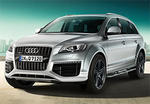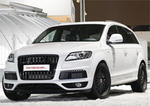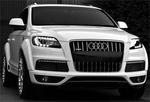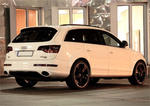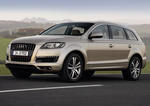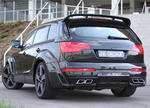
The Ingolstadt carmaker has unveiled today the new 2010 Audi Q7 facelift which promises lower fuel consumption on all the models and the world's cleanest diesel technology. The 2010 Audi Q7 3.0 TDI now comes with clean diesel technology which offers a fuel consumption 8.9 liters/100 km (26.43 US mpg).
As far as the design goes, the 2010 Audi Q7 facelift comes with a revised front grille and re-styled bumpers with integrated underbody protection in the center. The 2010 Audi Q7 facelift now comes with xenon plus headlights and LED daytime running lights. The side view of the 2010 Audi Q7 facelift shows new door moldings while the rear shows a two-tone bumper, a redesigned tailgate made from aluminum.
The petrol versions of the 2010 Audi Q7 facelift are powered by either a 3.6 FSI V6 engine with 206 kW (280 bhp) and 360 Nm or a 4.2 FSI V8 with 257 kW (350 bhp) and 440 Nm of torque. the diesel options of the 2010 Audi Q7 facelift include the 3.0 TDI with 176 kW (240 bhp) and 550 Nm and the new V12 TDI.
Audi Press Release:
When it was first rolled out three years ago, the 2010 Audi Q7 facelift performance SUV immediately achieved a leadership position – as a sporty, comfortable as well as high-performance recreational and business vehicle on a grand scale. Now Audi is making it even better – more elegant and more efficient, with lower emissions: the 2010 Audi Q7 3.0 TDI consumes only 9.1 liters per 100 kilometers (25.85 US mpg). And now it’s also available in a new version as a TDI clean diesel,


with the world’s cleanest diesel technology and even lower fuel consumption of only 8.9 liters/100 km (26.43 US mpg).
The Q7 is the large Audi for sporty individualists, for people who are seeking a vehicle that will take them anywhere they want to go for sports, recreation, and business. Its dynamic proportions and distinctive lines express this character, and subtle modifications endow its styling with even more elegance.
The design: The language of dynamics
At the front end, the large single-frame radiator grille has been redesigned. Vertical chrome bars contrast with its black high-gloss finish. The bumpers too have been restyled. Their lower section is now painted in a contrasting black or gray, depending on the body color. The newly integrated underbody protection in the center section of the bumper has a distinctive ribbed design.
As alternatives to the standard halogen headlights, Audi offers a xenon plus variant and a new adaptive-light system that integrates not only low-beam, high-beam and a special superhighway beam
but also turning and cornering lights. In conjunction with the xenon headlights, light-emitting diodes assembled to form U-shaped bands provide the daytime running lights. The front blinkers are also composed of LEDs as straight-line arrays, located at the upper edge of the air intakes.
The side view too, with its coupe-like roofline, low window area and tautly curved body surfaces, reinforces the dynamic look of the Q7. Door moldings have been modified to add interest. The lightweight alloy wheels are size 7.5 J x 18, the wheels size 235/60. In the V6 vehicles they have seven spokes, in the V8 versions they have six in size 8 J x 18.
At the rear end, the bumper has also been given two-tone paintwork; the tailgate, which includes a portion of the rear pillars in an S-shaped contour, has been given a new and distinctively 3D shape in the vicinity of the license plate bracket. To reduce the weight of the Q7, the tailgate has been made of aluminum, as have the engine hood and the fenders. Standard LEDs in the tail lights create a distinctive lighting pattern.
Eleven paint finishes for the 2010 Audi Q7 facelift include four new shades: Ibis White, Graphite Gray, metallic, Teak Brown, metallic, and Orca Black, metallic. An aluminum exterior package is optionally available from Audi: gleaming chrome bars in the bumpers and door moldings; the lower portion of the bumpers is painted in the body color; the center portion of the front apron and the diffuser are painted in a contrasting shade.
The interior: Room to spare
Thanks to its luxurious 300-centimeter (118.11-inch) wheelbase within an overall length of 5.09 meters (16.70 feet), the 2010 Audi Q7 facelift has interior room to spare, and the interior flexibility is unrivalled. The seatbacks in the second row are divided into three fold-down sections to provide a level cargo floor.
This increases the luggage space from a volume of 775 liters (27.37 cubic feet) to 2,035 liters (71.87 cubic feet). With the leather upholstery option, the middle seat now has an even more comfortable contour.
Two very useful features are optionally available: either a longitudinally displaceable second seat row or individual comfort seats that are separately displaceable. Another available option is a third row for passengers no taller than 1.60 meters (5.25 feet), combined with an improved easy entry function.
A multitude of detailed improvements in the interior enhance the elegance and the sense of well-being. The instrument cluster has been redesigned: the large, round, easily readable instruments are encircled by metallic frames. Interior lights in the door linings and an inlay on the passenger side enhance the interior styling. Many details of the control elements have been restyled and also enhanced by chrome elements.
The selection of interior colors and materials is also new. Upholstery fabrics are available in black and light gray; leather upholstery additionally also in Para Brown, Savannah Beige and Cardamon Beige. Standard inlays are finished in matt black. In optional design packages, aluminum and wood finishes are used.
The power train: Performance and efficiency
The 2010 Audi Q7 facelift is available with six powerful and highly efficient direct injection engines, two of them gasoline-powered and four diesel engines, including the world’s most powerful diesel SUV, the Audi Q7 V12 TDI. Their power is transmitted via a convenient and fast-shifting six-speed tiptronic to the quattro permanent all-wheel drive, which distributes it between the axles with slightly more than half to the rear.
The 3.0 TDI puts out 176 kW (240 bhp) and delivers as much as 550 Nm between 2,000 and 2,250 rpm, yet on the EU cycle it consumes only 9.1 liters / 100 km (25.85 US mpg). The optionally available 3.0 TDI clean diesel even consumes 0.2 liters (0.05 US gallons) less.
Despite highly complex exhaust gas recirculation and the resulting world’s cleanest diesel technology, it consumes just 8.9 liters/100 km (26.43 US mpg). It meets the strict LEV II Bin 5 US standard and already complies with the Euro 6 limits announced for 2014.
The technology of the TDI clean diesel is highly complex. An advanced version of the common rail injection system with 2,000 bars of pressure, new combustion chamber sensors and a high-performance exhaust recirculating system ensure a highly efficient combustion process. An innovative DeNOx catalytic converter reduces the remaining nitrogen oxides. Just upstream of it, a pump injects an additive named AdBlue into the hot exhaust flow, where this solution decomposes into ammonia, which splits the nitrogen oxides into harmless nitrogen and water. Audi partners replenish the additive during regular maintenance servicing.
In the 2010 Audi Q7 4.2 TDI too, fuel consumption has been drastically reduced – from 11.1 (21.19 US mpg) to 9.9 liters per 100 km (23.76 US mpg). Yet the V8 diesel is more powerful: with an output of 250 kW (340 bhp) and a torque of 760 Nm, it develops enormous propulsive power. This maximum torque is available in the range from 1,750 to 3,000 rpm.
At Audi, efficiency and dynamics go hand in hand. That’s also the case in gasoline engines. The 3.6 FSI, a V6 with a small cylinder angle, has a power output of 206 kW (280 bhp) and delivers 360 Nm between 2,500 and 5,000 rpm. Its average fuel consumption is 12.1 liters per 100 km (19.44 US mpg). The 4.2 FSI, a V8, delivers 257 kW (350 bhp) and 440 Nm at 3,500 rpm. Its fuel consumption is 12.7 liters/100 km (18.52 US mpg).
A novel technology from the Modular Efficiency Platform further improves fuel efficiency in all the engines: the recovery system, which during braking and coasting phases converts mechanical energy into electric energy and buffer-stores it in the battery. It reduces CO2 emissions by up to 5 g/km (8.05 g/mile).
The chassis: Safe and sporty
In its suspension technology too the 2010 Audi Q7 facelift is exceptional. As a customer option, Audi equips the Q7 with adaptive air suspension – a pneumatic suspension system that operates in conjunction with an electronic shock absorber control, varies the ground clearance at five different levels, and lets the driver select three driving modes: comfort, automatic and dynamic. In its road handling the Q7 excels in its sporty, highly responsive precision. Off-road, it provides a superior ride on widely varying terrains.
The choice of wheels ranges from 18 inches to the 10 J x 21 top version with 295/35 tires. Ten different designs are available, including two very elegant, high-luster, bicolor versions. Large brake discs provide superb deceleration – with 18-inch diameters front and rear.
Optionally available in the eight-cylinder models are carbon-fiber ceramic disk brakes which further enhance the dynamic character of this performance SUV: they are lighter than their steel equivalents, extremely abrasion-resistant and virtually fading-free. They achieve high driving performance and ensure short braking distances. The diameters of the ceramic discs are 420 millimeters (16.54 inches) in front and 370 millimeters (14.57 inches) at the rear. The calipers are black and adorned with the wording “Audi ceramic”. A total of 24 pistons are used on the front and rear axles.
The equipment: Luxury and high-tech
The Q7 comes with a splendid range of standard equipment. The speed-dependent servotronic steering system is standard, as is a double floor in the cargo area complete with a storage compartment and a dirt tray; there is also a roof rack, an automatic air conditioning system, and an MMI radio operating system complete with a CD audio player and eight loudspeakers.
The option program includes luxury features such as the remote key and four-zone automatic air conditioning. Another high-end option is the climate-controlled comfort seat, which can keep the body warm or cool it by means of small fans.
Particularly dynamic Q7 drivers may wish to consider one of two other quality option packages. The S line exterior package enhances the styling with details such as distinctive bumpers and a solid paint finish. The S line sports package includes a black interior, sport seats with Alcantara leather or Verano leather upholstery, aluminum trim (optionally in piano lacquer finish or birch grain wood), special exterior colors, 20-inch wheels, and a firmer setup for the steel spring suspension or the adaptive air suspension.
The Q7 also offers many intelligent solutions for the practical needs of everyday use – such as an electric luggage space cover, a reversible floor mat, a set of luggage rails, a removable ski bag, and a moveable storage box. The options program includes separation grids, an interior bicycle stand, various roof-mounted carriers, a distinctive off-road styling package, and a pivoting trailer hitch: this powerful SUV can tow up to 3.5 metric tons.
In the infotainment field, Audi provides a carefully differentiated selection of modules. The three optional systems are part of the new generation of Audi devices. The top-of-the-line version integrates a hard drive for navigation, music and telephone data, a high-resolution color monitor and 3D map graphics, a DVD player as well as voice control. It can be expanded into a luxury media center with features such as a Bluetooth telephone, a TV tuner, a digital radio tuner, plus rear seat entertainment. A very special highlight is the advanced sound system from Bang & Olufsen with its 14 channels, 1000 watts of power and 14 loudspeakers.
The range of optional equipment is rounded off by technologies from the luxury class. The radar-supported adaptive cruise control regulates the speed and the distance to the preceding vehicle in a range from 30 to 200 km/h (18.64 to 124.27 mph) by acceleration and deceleration. If a threat is detected, the integrated Audi braking guard warns the driver at two levels.
From a speed of 60 km/h (37.28 mph), Audi lane assist helps the driver stay in lane by means of a camera that recognizes the lane lines. Audi side assist ensures safe lane changes above 30 km/h (18.64 mph) with the aid of a radar system that monitors the traffic pattern within 70 meters (229.66 feet) behind the vehicle. Finally, the Audi parking system advanced assists parking by means of a rearview camera and reference lines on the onboard monitor.
The world’s strongest diesel SUV: The Audi Q7 V12 TDI
Even when it was first rolled out, the Audi Q7 V12 TDI, the world’s strongest diesel SUV, had a uniquely distinctive look resulting from its large air intakes. The new version features modifications to the interior and the rear end.
The V12 diesel, with a 6-liter (6,000 cc) engine closely related to that of the R10 TDI racing car – a triple Le Mans winner – delivers 368 kW (500 bhp) and develops a torque of 1,000 Nm between 1,750 and 3,250 rpm.
Acceleration from zero to 100 km/h (62.14 mph) in 5.5 seconds and a capped top speed of 250 km/h (155.34 mph) equal the driving performance of a powerful sports car. Despite these impressive performance data, the V12 diesel gets by on an average of 11.3 liters of fuel per 100 km (20.82 US mpg). Its luxurious standard equipment includes 20-inch wheels, a Bose sound system, and many additional features.
Product Improvement Summary
• Exterior updates:
o New front lighting design and LED daytime running lights
o New full LED rear lights (LED running lights, brake lights, and turn signals)
o Added chrome finishes on bumpers, door panels, and door handles
o Two-tone exterior mirrors
o New wheel designs
o Updated front/rear bumpers
o New paint colors (Teak Brown, Graphite Gray)
o Rear tailgate has new shape for worldwide license plate acceptance
• Interior updates:
o Ventilated Premium Cricket leather front seats
o Ambient interior door lighting and additional chrome enhancements on switchgear
o Additional wood decorative inlay on passenger side dash
• Infotainment:
o New MMI navigation system – third generation MMI shows latest evolution of 3D navigation, joystick control for navigation map destination finding, updated graphical clarity, SIRIUS artist/title preview, SIRIUS traffic-based navigation, voice-based destination input control, and voice inputs such as “I’m hungry,” “I need money,” “I need gas” and “I need coffee” that will point to closest options within current vicinity.
• Launch Timing and Pricing:
o 2010 Audi Q7 facelift with product improvement features launches in Fall 2009 as a 2010 model year vehicle. Pricing will be announced closer to launch.
FSI gasoline direct injection summary
• Audi FSI direct injection gasoline technology was born in the R8 Le Mans-winning sports car found on racetracks from 2000-2005, with its first U.S. application in the 2005 A6 3.2 FSI V6 sedan launching in late 2004 calendar year. Using many of the same principles as TDI clean diesel technology, its high compression ratios allow for more power and torque with better fuel economy, while increasing performance levels from previous engine generations. 2010 Audi Q7 facelift’s 3.6 FSI V6 engine and its 4.2 FSI V8 engines complement the TDI clean diesel engine joining the Audi Q7 family in April 2009.
TDI clean diesel Summary
• Audi TDI clean diesel is clean, quiet, efficient, and fast. Customers buy this technology because it saves them time and adds convenience because of its city/highway range, all in a very clean and high-tech manner.
• Audi TDI clean diesel engines are held to the same emissions standards as gasoline engines in the U.S., plus offer the advantages of 30% better fuel economy than V6 gasoline engines of similar displacement. Audi recommends premium gasoline fuel for FSI direct injection engines, with similar pricing for ultra low sulfur diesel fuel available in the U.S.
• With 25 mpg highway and over 600 highway miles of range, Audi has chosen the 2010 Audi Q7 facelift to launch diesel to demonstrate the best of qualities of fuel efficiency and technology in a vehicle segment that is not known for these attributes.
• Audi has been preparing the U.S. market for TDI clean diesel by racing the R10 TDI LMP1 prototype for the past three seasons within the American Le Mans series, with proven and equally consistent victories for all three competing years at the famed 24 Hours of Le Mans endurance race. The 650 hp and 800 lb-ft of torque within the R10 TDI is proof of Audi endurance, reliability, performance, and high levels of technology. It has always used the futuristic and high-potential GTL (gas-to-liquid) clean diesel fuel and has experimented with BTL (biomass-to-liquid) fuel in the 2008 24 Hours of Le Mans endurance race. The new R15 TDI sports car with a V10 TDI clean engine won its maiden competition at the March 2009 12 Hours of Sebring endurance race. Preparations are well under way for its first 24 Hours of Le Mans racing debut in June 2009.
• Audi TDI clean diesel development since 1989: output up 100%, torque up 70%, cleaner by 95%, particulates reduced by 98%.
Market
• Key competitors are BMW X5 xDrive30i, xDrive35d, and xDrive48i and Mercedes GL320 BlueTEC, GL450, and GL550.
Why TDI clean diesel in the United States in 2009 with the new Audi Q7 TDI?
• Audi has achieved Bin5/ULEV (ultra low emissions vehicle) II 50-state status. Audi clean diesel is measured on the same emissions basis as gasoline-based engines, but with 30% better fuel efficiency.
• Advantages include very American driving aspects such as long range with over 600 highway miles between fueling stops for a convenient lifestyle, off-the-line power/torque, smooth and quiet ride.
• When comparing diesel fuel prices 1:1 to Audi-recommended Super unleaded gasoline, the price differential will pay for itself over a few years time, and even sooner if resale value, and the Alternative Motor Vehicle credit is taken into consideration.
• Clean diesel is progressive, in line with Audi worldwide brand values, with its advanced technology and performance without sacrificing efficiency.
Design
• Sporty coupe-like roofline and dynamic sill line divides vehicle into a sporty looking upper section and a sturdy / substantial lower section.
• One-piece wraparound tailgate made of aluminum with dynamic S-joint; unique to Audi.
• Striking single-frame grille is a symbol of power and presence.
• Typical Audi interior design is modern and sophisticated, with clear attention to detail; 14 cupholders, including 1 liter bottle holders in each door; up to 28 rear seat configurations possible.
• 5-star crash test ratings from NHTSA NCAP, “Top Safety Pick” from IIHS
• Interior design was developed with the U.S. in mind, with ample storage room, numerous cupholders, and overall spaciousness.
• 3.0 TDI V6 clean diesel advantages include superior packaging over competitors, with AdBlue filling area secured next to fuel filling area within exterior fuel door (not in the interior).
Dynamics
• S line package option provides up to 21 inch wheels with 295/35 tires
• Six-piston front and four-piston rear brakes provide ample stopping power
• Turbocharger optimized for US market, with torque peak arriving sooner than current EU model.
• Clean, fun-to-drive, responsible, with excellent range fits U.S. Audi customer profile
Powertrain
• 3.6 FSI V6 specifications:
o FSI direct injection technology
o 280 hp / 266 lb-ft
o 0-60 in 8.2 seconds
o Fuel economy: 14/20 city/highway, 16 mpg combined
• 3.0 TDI V6 clean diesel with 50-state specifications joins the U.S. 2010 Audi Q7 facelift lineup in April 2009:
o TDI clean diesel technology and Bin 5 federal and ULEV II California emissions rating
o U.S. version: 225 hp / 406 lb-ft
o 0-60 mph in 8.5 seconds (USA estimated)
o Range: over 600 miles per tank (25mpg x 26.4 gal tank = 660 miles)
o Common rail engine design for smooth and quiet operation, injection pressure up to 2,000 BAR / 29,001 psi = the weight of an SUV within the size of a fingernail.
o Piezo injectors can be varied and optimized almost at will, reducing emissions, and acoustic benefits of the engine (especially at low engine speeds).
o Variable turbine geometry generates 23.2 lbs of boost (1.6 BAR), with its vanes powered by an electric servo motor to improve propulsive power at low speeds.
o Engine block made from a high strength vermicular graphite iron. Cylinder heads made from aluminum, which weighs 15% less than traditional cast iron.
o Quickstart heater plugs are adapted to extremely cold temperatures, heating up to 1800°F within 2 seconds of ignition.
o AdBlue tanks can be refilled under normal Audi U.S. maintenance cycles.
o AdBlue tanks do not compromise the ability to carry a collapsible spare wheel (same as 2010 Audi Q7 facelift gasoline models).
o Fuel economy: 17/25 city/highway, 20 mpg combined
• 4.2 FSI V8 specifications
o FSI direct injection technology
o 350 hp / 325 lb-ft
o 0-60 in 7.1 seconds
o Fuel economy: 13/18 city/highway; 15 mpg combined
• quattro® AWD – latest generation with asymmetric rear-biased torque split (42% front / 58% rear under normal conditions)
Innovations and available features
• Advanced key keyless entry and starting
• Bluetooth hands-free telephone interface
• Audi music interface – iPod adapter
• Audi parking system advanced w/ rearview camera (includes front & rear acoustic sensors)
• 6,600 lbs towing capacity with available towing package
• Audi side assist blind spot detection system (activates at 19 mph)
• Bang and Olufsen 1001 watts / 14 speaker Advanced sound system
• Four zone climate control
• Heated front & rear seats, and steering wheel
• Audi adaptive air suspension (height & damping adjustment)
• Audi adaptive cruise control (0-90 mph, can bring car to a complete stop)





